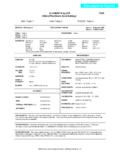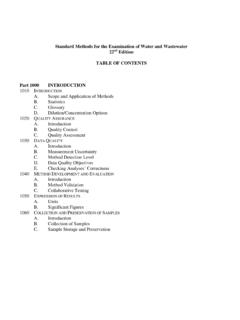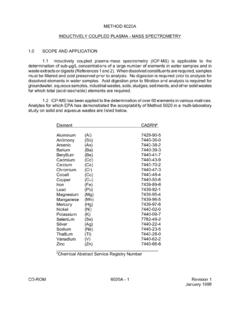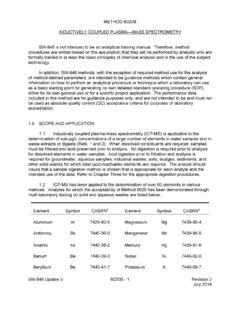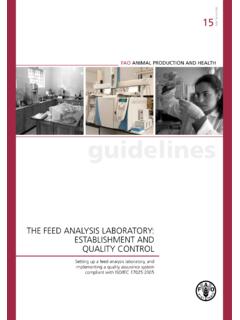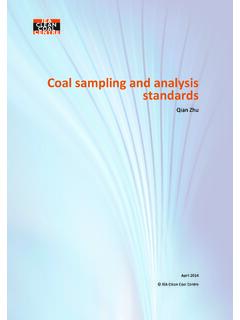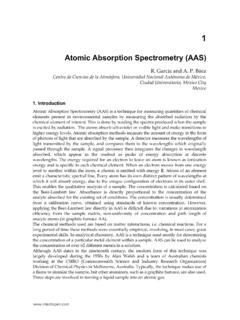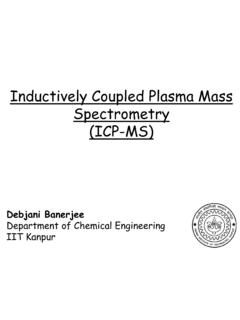Transcription of METHOD 3052 MICROWAVE ASSISTED ACID DIGESTION OF …
1 CD-ROM3052 - 1 Revision 0 December 1996 METHOD 3052 MICROWAVE ASSISTED ACID DIGESTION OF SILICEOUS ANDORGANICALLY BASED SCOPE AND METHOD is applicable to the MICROWAVE ASSISTED acid DIGESTION of siliceousmatrices, and organic matrices and other complex matrices. If a total decomposition analysis(relative to the target analyte list) is required, the following matrices can be digested: ashes,biological tissues, oils, oil contaminated soils, sediments, sludges, and soils. This METHOD isapplicable for the following elements:AluminumCadmiumIronMolybdenumSo diumAntimonyCalciumLeadNickelStrontiumAr senicChromiumMagnesiumPotassiumThalliumB oronCobaltManganeseSeleniumVanadiumBariu mCopperMercury SilverZincBerylliumOther elements and matrices may be analyzed by this METHOD if performance is demonstrated forthe analyte of interest, in the matrices of interest, at the concentration levels of interest (see ).
2 Note: This technique is not appropriate for regulatory applications that require the use ofleachate preparations ( , METHOD 3050, METHOD 3051, METHOD 1311, METHOD 1312, Method1310, METHOD 1320, METHOD 1330, METHOD 3031, METHOD 3040). This METHOD is appropriatefor those applications requiring a total decomposition for research purposes ( , geologicalstudies, mass balances, analysis of Standard Reference Materials) or in response to aregulation that requires total sample METHOD is provided as a rapid multi-element, MICROWAVE ASSISTED acid digestionprior to analysis protocol so that decisions can be made about the site or material. Digests andalternative procedures produced by the METHOD are suitable for analysis by flame atomic absorptionspectrometry (FLAA), cold vapor atomic absorption spectrometry (CVAA), graphite furnace atomicabsorption spectrometry (GFAA), inductively coupled plasma atomic emission spectrometry (ICP-AES), inductively coupled plasma mass spectrometry (ICP-MS) and other analytical elementalanalysis techniques where applicable.
3 Due to the rapid advances in MICROWAVE technology, consultyour manufacturer's recommended instructions for guidance on their MICROWAVE DIGESTION systemand refer to this manual s "Disclaimer" when conducting analyses using METHOD goal of this METHOD is total sample decomposition and with judicious choice ofacid combinations this is achievable for most matrices (see Sec. ). Selection of reagents whichgive the highest recoveries for the target analytes is considered the optimum METHOD - 2 Revision 0 December OF representative sample of up to g is digested in 9 mL of concentrated nitric acidand usually 3 mL hydrofluoric acid for 15 minutes using MICROWAVE heating with a suitable laboratorymicrowave system. The METHOD has several additional alternative acid and reagent combinationsincluding hydrochloric acid and hydrogen peroxide.
4 The METHOD has provisions for scaling up thesample size to a maximum of g. The sample and acid are placed in suitably inert polymericmicrowave vessels. The vessel is sealed and heated in the MICROWAVE system. The temperatureprofile is specified to permit specific reactions and incorporates reaching 180 5 C in approximatelyless than minutes and remaining at 180 5 C for minutes for the completion of specificreactions (Ref. 1, 2, 3, 4). After cooling, the vessel contents may be filtered, centrifuged, or allowedto settle and then decanted, diluted to volume, and analyzed by the appropriate SW-846 DIGESTION reaction products, very reactive, or volatile materials that maycreate high pressures when heated and may cause venting of the vessels with potential loss ofsample and analytes. The complete decomposition of either carbonates, or carbon based samples,may cause enough pressure to vent the vessel if the sample size is greater than g.
5 Variationsof the METHOD due to very reactive materials are specifically addressed in sections and samples will be totally dissolved by this METHOD with judicious choice of the acidcombinations. A few refractory sample matrix compounds, such as TiO2, alumina, and other oxidesmay not be totally dissolved and in some cases may sequester target analyte elements. use of several DIGESTION reagents that are necessary to either completelydecompose the matrix or to stabilize specific elements may limit the use of specific analyticalinstrumentation methods. Hydrochloric acid is known to interfere with some instrumental analysismethods such as flame atomic absorption (FLAA) and inductively coupled plasma atomic emissionspectrometry (ICP-AES). The presence of hydrochloric acid may be problematic for graphite furnaceatomic absorption (GFAA) and inductively coupled plasma mass spectrometry (ICP-MS).
6 Hydrofluoric acid, which is capable of dissolving silicates, may require the removal of excesshydrofluoric acid or the use of specialized non-glass components during instrumental 3052 enables the analyst to select other decomposition reagents that may also causeproblems with instrumental analyses necessitating matrix matching of standards to account forviscosity and chemical AND apparatus temperature performance requirements necessitate the microwavedecomposition system sense the temperature to within and automatically adjust themicrowave field output power within 2 seconds of sensing. Temperature sensors should beaccurate to 2EC (including the final reaction temperature of 180EC). Temperature feedbackcontrol provides the primary control performance mechanism for the METHOD .
7 Due to theflexibility in the reagents used to achieve total analysis, tempertuare feedback control isnecessary for reproducible MICROWAVE - 3 Revision 0 December 1996 Alternatively, for a specific set of reagent(s) combination(s), quantity, and specific vesseltype, a calibration control mechanism can be developed similar to previous microwavemethods (see METHOD 3051). Through calibration of the MICROWAVE power, vessel load andheat loss, the reaction temperature profile described in Section can be calibration settings are specific for the number and type of vessel used and for themicrowave system in addition to the variation in reagent combinations. Therefore no specificcalibration settings are provided in this METHOD . These settings may be developed by usingtemperature monitoring equipment for each specific set of equipment and reagentcombination.
8 They may only be used if not altered as previously described in other methodssuch as 3051 and 3015. In this circumstance, the MICROWAVE system providesprogrammable power which can be programmed to within 12 W of the required systems provide a nominal 600 W to 1200 W of power (Ref. 1, 2, 5). Calibrationcontrol provides backward compatibility with older laboratory MICROWAVE systems withouttemperature monitoring or feedback control and with lower cost MICROWAVE systems for somerepetitive analyses. Older lower pressure vessels may not be temperature measurement system should be periodically calibrated at anelevated temperature. Pour silicon oil (a high temperature oil into a beaker and adequatelystirred to ensure a homogeneous temperature. Place the MICROWAVE temperature sensorand a calibrated external temperature measurement sensor into the beaker.)
9 Heat the beakerto a constant temperature of 180 5 C. Measure the temperature with both sensors. If themeasured temperatures vary by more than 1 - 2 C, the MICROWAVE temperaturemeasurement system needs to be calibrated. Consult the MICROWAVE manufacturer sinstructions about the specific temperature sensor calibration : The use of MICROWAVE equipment with temperature feedback control isrequired to control the unfamiliar reactions of unique or untested reagentcombinations of unknown samples. These tests may require additional vesselrequirements such as increased pressure MICROWAVE unit cavity is corrosion resistant and well ventilated. Allelectronics are protected against corrosion for safe : There are many safety and operational recommendations specific to themodel and manufacturer of the MICROWAVE equipment used in individual listing of these specific suggestions is beyond the scope of this METHOD and requirethe analyst to consult the specific equipment manual, manufacturer, and literature forproper and safe operation of the MICROWAVE equipment and METHOD requires essentially MICROWAVE transparent and reagent resistantsuitably inert polymeric materials (examples are PFA or TFM suitably inert polymericpolymers) to contain acids and samples.
10 For higher pressure capabilities the vessel may becontained within layers of different MICROWAVE transparent materials for strength, durability,and safety. The vessels internal volume should be at least 45 mL, capable of withstandingpressures of at least 30 atm (30 bar or 435 psi), and capable of controlled pressure specifications are to provide an appropriate, safe, and durable reaction vessel ofwhich there are many adequate designs by many - 4 Revision 0 December 1996 CAUTION: The outer layers of vessels are frequently not as acid or reagent resistantas the liner material and must not be chemically degraded or physically damaged toretain the performance and safety required. Routine examination of the vesselmaterials may be required to ensure their safe : The second safety concern relates to the use of sealed containers withoutpressure relief devices.










